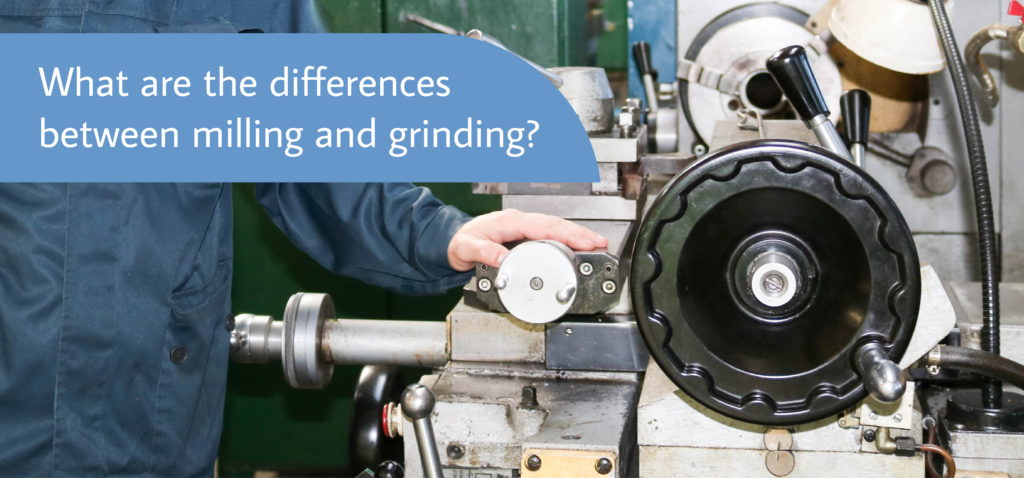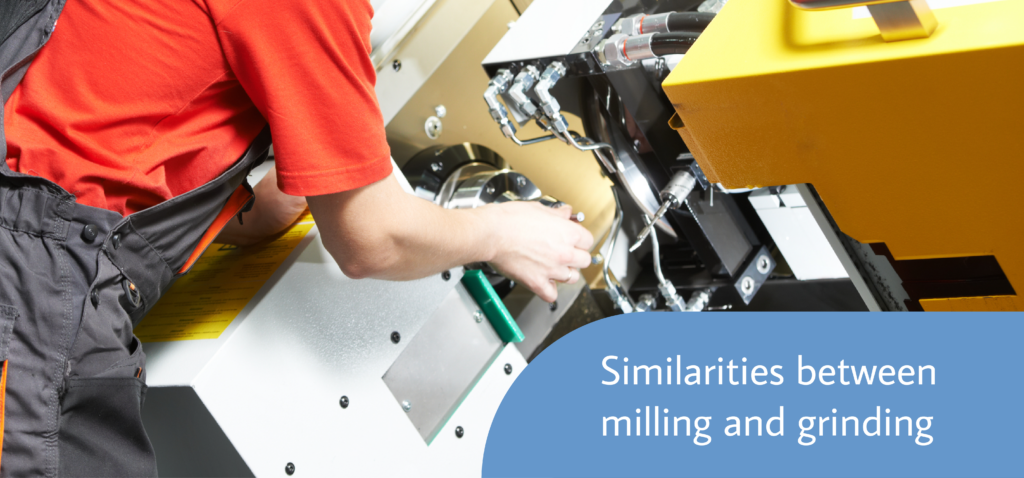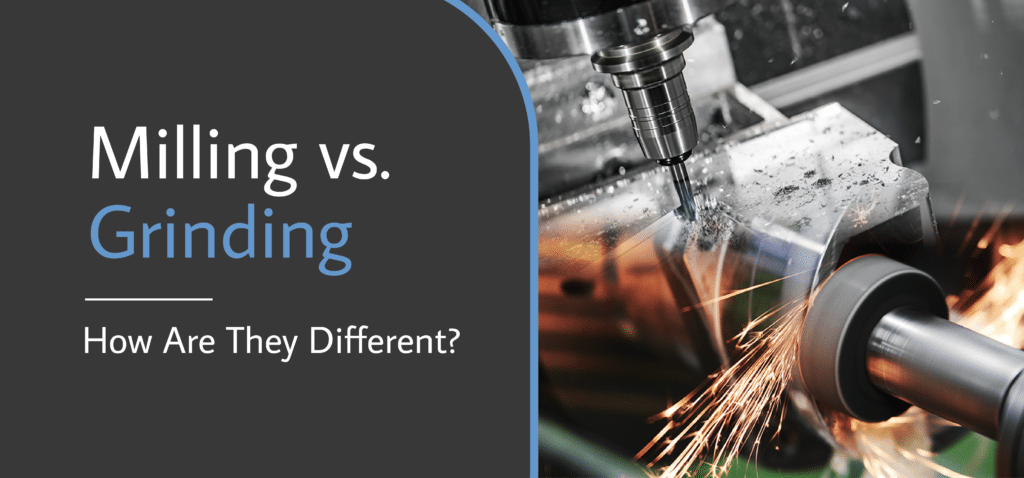Disclaimer: As an Amazon affiliate, I may earn a small percentage from qualifying purchases. This is at no extra cost to you. Learn more here.
Last Updated on February 28, 2023 by Charles Wilson
The milling and grinding processes are similar machining processes that prioritize material removal but differ in various ways.
Either machining operation can handle materials like metal, but it’s important to know which tool to pick up for the job.
So what’s the difference between them? I’ll cover their differences and what they’re better at here.
Key Takeaways
- The milling and grinding processes involve the physical removal of material from a workpiece.
- The cutting action of both processes can generate chatter and result in imperfections in the surface of the work material.
- Either cutting tool can be used to machine metals and other alloys.
What Is Milling?

Milling is a basic machining process where a moving cutting tool passes against a stationary workpiece. It’s similar to turning but with a differently-shaped workpiece.
Milling machines can handle materials like steel, iron, or aluminum, along with plastics like fiberglass and PVC.
A milling machine can remove material from workpieces of varying hardness, but this can damage the cutting tool due to overheating or chipping.
As a cutting tool moves across a workpiece, it’ll continuously shape and remove material from it, shrinking the surface and machining a finished product.
This machining process can be divided into two general categories: Face and Peripheral. Peripheral milling has a higher material removal rate than face milling.
Face milling has the cutting tool positioned perpendicular to the workpiece, while peripheral milling positions the cutter parallel to the workpiece’s surface.
What Is Grinding?

Grinding is a different machining process that uses a grinding wheel as its cutting tool. The grinding wheel is formed by a set of grains bonded together into a disc shape.
The cutting tools used in mills must be sharpened regularly during machining to avoid the risk of damage, but the abrasive grains on a grinder fall off with use, revealing the sharp and fresh grains underneath.
Grinding wheels are normally self-sharpening, but I’ve found that they require the application of coolant to wash away chips and swarf from the wheel for a longer wheel life.
Grinding is a more accurate and precise machining process than milling because the abrasive can be adapted to either provide a finish or remove material.
You can’t call a workpiece “finished” until you’ve taken a grinder to it since the surface requires time with a grinding wheel to be smooth.
What Are the Differences Between Milling vs. Grinding?

The main difference between milling and grinding is the machine tool used for the process.
A milling machine is used in the former machining process, while a grinding wheel is employed for the latter machining process.
Tool Points
A grinder’s abrasive tool is essentially a multi-point cutter because of its composition. Since a grinder is made from abrasive grains bonded together, it’s essentially multiple tools in one package.
In contrast, mills use multiple single-point cutting tools to work material, and they need to be replaced when worn out.
The best way I’ve found to give your tools a longer use life is to apply coolant as needed and match your tools to your material.
For example, if you plan on machining a tougher material, ensure that your grinder’s tensile strength is up to scratch to avoid thermal cracking.
Materials
Most milling machines I’ve used have tools made from metals. They’re also typically tougher than what the workpiece is made of or can be made from materials like diamond or ceramic.
In contrast, grinding wheels are always made from an abrasive like cubic boron nitride or diamond bonded together.
This means cutting tools for mills are typically more durable than grinding wheels, which helps them sustain operation for longer.
MRR (Material Removal Rate)
Between the two machining processes, I’ve found that milling has a high MRR compared to grinding, so it’s better for bulk material removal.
In contrast, grinding is the more suitable machining operation if you have a partially-machined work surface that needs minor tweaks or finishing touches.
Grinding can also be used for machining large billets of material, but it’s more useful for metal. Milling is more versatile because you can also turn plastics.
Accuracy
I’ve machined with both a grinding wheel and a milling machine, and I’ve found that the grinder is the more accurate machine tool.
If you just want to remove material, either cutting tool will do, but you’ll need the grinder if you want close tolerance in your parts. That’s why grinding is preferred for more precise manufacturing processes.
A mill’s limited hardness means you can typically only machine a workpiece with a larger surface. Milling a smaller surface won’t get you anywhere, but grinding it is still possible.
Tolerance for Interrupted Cuts
A milling machine’s cutting tools have a much lower tolerance for interrupted cuts, and you may spend a fortune on replacements!
In contrast, using a grinder properly involves repetitive interrupted cuts. This also helps with the application of coolant through the abrasive.
Whether you’re milling or grinding, take care to avoid chatter so you can keep your workpiece and tools free from damage.
Similarities Between Milling and Grinding

These machines aren’t all different; they have some similarities, too.
Machinable Materials
The main similarity I’ve found between these two tools is the materials they can handle, primarily metal like steel and brass.
However, milling can handle machining a wider variety of workpieces. Mills can work plastic and alloys, while a grinder is typically limited to harder materials.
Purpose
Both grinders and milling machines feature a cutting action and a cutting tool that runs either across or into a workpiece to remove material.
It’s the same idea for both tools but different execution. Their accuracy and efficacy are also different, as mills are generally less accurate than grinders.
Frequently Asked Questions (FAQs)
Learn more about these two different machining processes here.
Is Grinding Better Than Milling?
If you want your final workpiece to have a better finish, it’s better to grind it rather than mill it. That’s because a milling machine has limited accuracy compared to a grinding wheel.
Grinding is better than milling if you want your material to have a smooth and polished surface, regardless of the hardness of your material.
Which Is More Beginner Friendly?
Beginners should stick to milling before moving up to grinding, especially if they’ve never touched a grinding wheel.
The abrasive cutting action of a grinding wheel can be harder to deal with than a mill, and your hands can slip during the manufacturing process. Wear the proper safety gear!
Final Thoughts
The primary purpose of milling and grinding is to remove material from a workpiece but for different purposes.
A milling machine’s more versatile than a grinding wheel, but both tools are needed for manufacturing.
Before you begin machining a workpiece, ensure you head to the right piece of equipment to make machining any material easier!

